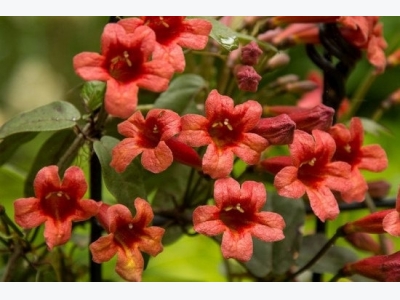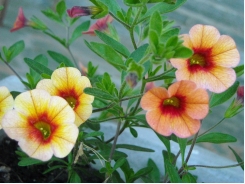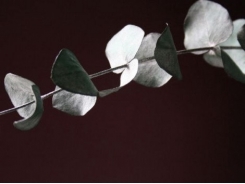How to Grow Crossvine

Crossvine is a graceful vining plant loaded with lustrous green leaves and bright, trumpet-shaped flowers during late spring and throughout summer.
You won't want to miss nature's show with these amazing blossoms, and you won't forget the crossvine's beauty once you've seen it.
The crossvine (Bignonia capreolata) is an evergreen native to the United States where it grows wild in many of the southeastern states. In its uncultivated environment, it vines into trees and climbs up to 30 feet high. It's a tenacious grower that, when trained, will add living beauty to your outdoor structures. Its unusual capability to embrace vertical walls with its special adhesive structures makes crossvine an alluring natural decoration for porches, fences, and large trellises. Crossvine is a nice alternative to the trumpet vine, which has invasive tendencies. You can enjoy the crossvine's draping and climbing till your heart's content in U.S. Department of Agriculture Hardiness Zones 6 through 9.
How to Grow and Care for Crossvine
Crossvine is an easy plant to grow from seed. You can collect the seeds from pods that grow on the plant after the blossoms fade. Allow the pods to dry right on the woody vine. Once the pods have dried, open them up and harvest the seeds. You can also find crossvine seeds at your local nursery or from online vendors.
You can choose to plant your seeds directly in the ground in the fall or in the spring after the last frost. Or you can start seeds indoors 4 weeks prior to the last frost and introduce your transplant outdoors after the last frost. Some nurseries sell young crossvine plants that you can buy and transplant, too.
Another option for propagating crossvine it to take a root cutting. A root cutting should be done when this perennial plant has gone dormant for the year. Anytime from November to February is ideal. Dig into the ground to find the roots of the crossvine plant you are harvesting from. Select 2 to 3 pencil thick roots to clip off from both sides of the plant. Clip in 3 to 4 inch sections.
Cover the bare roots of the mother plant that have been exposed with some new garden soil, and water that plant well. Then, bundle and tie the cut root sections together. Dig a hole as deep as a five gallon bucket, and fill the hole with several inches of sand. Place the bundle in the hole, cover with gardening soil and water the area. Mark the spot where you have stored your crossvine root cuttings underground.
The cuttings can be stored underground for several weeks or longer. When the danger of frost has passed, dig your bundle up. You may notice that your roots are developing shoots and that's good, but it's okay if they haven't yet. Plant them vertically in the ground in the site you have chosen for your new crossvine plant.
Choose a sunny location to plant your crossvine. Although the plant will grow well in partial shade, you will enjoy a more abundant flowering season if you provide your plant with full sun. Plant your seeds or seedlings in good soil amended with a handful or two of organic material to start things off just right.
Your crossvine will prefer moist, well-draining soil. It will not like to be soggy, but it will not do well if allowed to dry out either. Prune your crossvine for aesthetic purposes and for overcrowding right after its flowers disappear in the late summer. Fertilize your crossvine with an organic plant food early in the spring and again after its flowers fade if you notice your vines could use a boost.
Crossvine Pests and Problems
Crossvine is generally a hardy vining plant. It is not prone to disease or infestations. In fact, it tends to attract hummingbirds, butterflies, and other wildlife, which are rarely considered pests.
Crossvine Varieties to Consider
'Tangerine Beauty' is the most popular crossvine. It boasts apricot-colored blooms and is easy to grow and maintain.
'Jekyll' is another easy to grow crossvine. With yellow-colored flowers, you can enjoy a more golden cascade.
Có thể bạn quan tâm
Phần mềm

Phối trộn thức ăn chăn nuôi

Pha dung dịch thủy canh

Định mức cho tôm ăn

Phối trộn phân bón NPK

Xác định tỷ lệ tôm sống

Chuyển đổi đơn vị phân bón

Xác định công suất sục khí

Chuyển đổi đơn vị tôm

Tính diện tích nhà kính

Tính thể tích ao hồ



 How to Grow Boxwood Shrubs
How to Grow Boxwood Shrubs  How to Get Rid of Invasive Bamboo
How to Get Rid of Invasive Bamboo